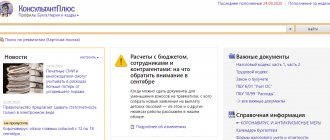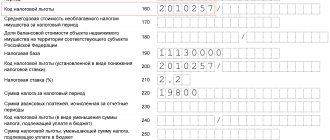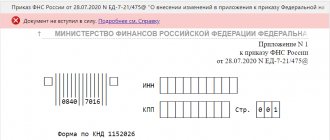Use these ConsultantPlus materials for free to correctly calculate and pay property taxes:
- Postponement of payment deadlines for taxes and insurance premiums due to the COVID-19 coronavirus pandemic.
- Background information: property tax rates for organizations in the constituent entities of the Russian Federation.
- Ready-made solution: how to calculate and pay corporate property tax.
- Typical situation: payment and reporting of property taxes.
- Tax accounting and reporting forms: forms and samples of completion.
The legislation regarding property tax has changed. We will show you how to calculate the property tax of an organization, how to correctly determine the tax base, how to calculate property tax based on cadastral value and, finally, what a property tax calculator is and how to use it.
Tax and reporting periods
The tax period for which the property tax of organizations is calculated is the calendar year (Clause 1, Article 379 of the Tax Code of the Russian Federation).
The reporting periods of the calendar year depend on the tax base (clause 2 of Article 379 of the Tax Code of the Russian Federation):
| The tax base | Reporting periods |
| calculated based on the average annual cost | I quarter, half year, 9 months |
| calculated based on the cadastral value | I quarter, II quarter, III quarter |
During established reporting periods, calculations for advance payments are provided to the tax authorities no later than 30 calendar days from the end of the corresponding reporting period (clause 2 of Article 386 of the Tax Code of the Russian Federation).
Features of taxation
The calculation of the property tax of organizations, as well as the general requirements for the specified obligation to pay tax, are defined in Chapter. 30 Tax Code of the Russian Federation. The tax is recognized as regional, that is, the authority to determine the rates, terms and procedure for payment and additional benefits has been transferred to the constituent entities of the Russian Federation. Tax rates and the procedure for applying differentiating coefficients are approved by regional legislative acts.
Payers are legal entities that own (on balance, for temporary use) movable or immovable fixed assets that are recognized as an object of taxation. Budgetary institutions do not have preferential benefits. Lists of objects that are not subject to taxation and preferential categories of institutions are presented in detail in Art. 374 and 381 of the Tax Code of the Russian Federation.
Privileges
Taxpayers have the right to take advantage of the benefits enshrined in paragraph 3 of Art. 56, paragraph 2, art. 372 of the Tax Code of the Russian Federation. There are only two types of privileges:
- Federal benefits that apply throughout the country. This privilege can be used by all taxpayers who meet the stated requirements. Enshrined in Article 381 of the Tax Code of the Russian Federation.
- Regional relaxations, which are approved by the authorities of the constituent entities of Russia. The rules on benefits apply exclusively within a specific region.
Attention! If an organization applies a regional tax benefit, then it is necessary to follow the legislation of the constituent entity of the Russian Federation.
You can check the current regulations on the official website of the Federal Tax Service. If a specific type of benefit is not approved, abolished, or canceled for the corresponding calendar year, then you cannot use the privilege. You will have to calculate the tax in full.
General calculation rules
Let's start with the general rules. Traditionally, property taxes are levied on assets that, according to accounting rules, are listed as fixed assets. This is provided for in Articles 373 and 374 of the Tax Code. That is, these are all those things that “hang” on accounts 01 and 03. Accordingly, the objects are owned by the company.
Let us recall that in accounting, values of this kind are reflected in accordance with PBU 6/01 “Accounting for Fixed Assets” and Methodological Instructions approved by Order of the Ministry of Finance of Russia dated October 13, 2003 No. 91n.
Previously (until 2013), taxes were imposed on both movable and immovable property. Accordingly, a business that owned only cars or trucks would still have to pay property taxes.
and UTII payers are not recognized as property tax payers.
Now, movable things are not considered objects of taxation. This is stated in the current version of subparagraph 8 of paragraph 4 of Article 374 of the Tax Code. We will talk about movable property in more detail. Whether or not you need to pay tax on other types of fixed assets, the table on page 31 will help you figure it out.
Preparing for calculations
Let's distribute all property recorded in accounts 01 and 03 into 5 groups:
| № | Groups | A comment |
| I | Real estate for which the cadastral value has been determined | The cadastral value of objects is posted on the official website of Rosreestr (https://rosreestr.ru) |
| II | Real estate for which there is no cadastral valuation | Real estate recorded on the balance sheet for which there is no cadastral value |
| III | Objects exempt from taxation | The list is given in paragraph 4 of Art. 374 Tax Code of the Russian Federation |
| IV | Preferential objects | The list is given in Art. 381 Tax Code of the Russian Federation |
| V | Other | Property that does not fall into any of the above groups |
Once we have decided on the fixed assets, we will proceed to filling out the calculation.
Property with cadastral value
While maintaining the general principles of calculating property tax in relation to some real estate, a different rule for calculating their value is provided: they are included in the tax base at their cadastral value as of January 1 of the tax period. At the moment, in most constituent entities of the Russian Federation, the cadastral value is determined for residential premises, administrative buildings, business and shopping centers, office premises and similar objects.
For them, the quarterly amount of advance payments for property tax is determined as ¼ of the product of the cadastral value of the property and the tax rate. Of course, in this case we are again talking about cases where the organization is obliged to make advance payments.
In such a situation, the annual report contains advance payments for property tax with the same figures in each quarter, of course, if the company does not have additional real estate with cadastral value during the year. An alternative option, when advances are not provided, is to pay the tax immediately at the end of the year. In this case, the payment amount is not divided into its component parts during the year.
In this regard, it should also be noted that if the cadastral value as of January 1 of the reporting year has not been determined, then the property tax is calculated according to the rules described above, that is, based on the average annual value of the property, even if the situation with the cadastral valuation has changed during the year. Changes in the cadastral value of an object are also not taken into account when calculating tax for the current or previous periods, unless we are talking about correcting an error made in the state register.
Calculation of property tax for legal entities
General filling requirements
Here are some features of filling out advance calculations:
- If there are no indicators, a dash is entered in the fields. The dash is drawn along the entire length of the field.
- Cost indicators are indicated in full rubles.
- All sheets indicate the checkpoint and tax identification number of the organization.
Letter No. BS-4-21/ [email protected] provides additional clarifications:
- the obligation to certify the declaration with the seal of a legal entity is excluded;
- The code for the type of economic activity according to the OKVED classifier has been excluded.
Let's consider the procedure for filling out the calculation sections (KND 1152028).
Procedure for filling out section 1
Section 1 is the last to be filled out - the final sheet. It reflects the amount of the advance payment to be paid to the budget at the place of provision. Filled out in the context of the corresponding codes according to OKTMO and KBK. The codes must comply with the following references:
- OKTMO code - directory OK 033-2013 (approved by Order of the Federal Agency for Technical Regulation and Metrology dated June 14, 2013 No. 159-st);
- KBK - instructions on the procedure for applying the budget classification of the Russian Federation (approved by Order of the Ministry of Finance of Russia No. 132n dated 06/08/2018).
The amount of the advance payment is indicated in line 030 of the calculation and is determined by summing the following lines for all sections:
Line 030 = (Section 2: 180 – 200) + (Section 3: 090 – 110).
Procedure for filling out section 2
This section reflects the tax base based on the residual value of assets.
To calculate property tax and to calculate the average annual value for the period, the residual value recorded on the balance sheet as of the 1st day of each month, starting from January 1, and at the end of the reporting period is included.
The formula for calculating property tax is:
To determine the number of months in the reporting period, the number of months in the period + 1 is taken into account. For example, when calculating for the first half of the year, the number of months will be 7 = (6 + 1).
The residual value of fixed assets as of the 1st day of each month is reflected in the calculation table (lines 020–110). Column 3 reflects the residual value of real estate, which is recognized as an object of taxation.
To fill it out correctly, you need to return to the 5 groups listed in the table above. The tabular part of the calculation indicates objects that are assigned to groups II, IV and V.
IMPORTANT!
Section 2 does not reflect tax-exempt real estate.
Procedure for filling out section 2.1
Section 2.1 is completed for real estate objects for which the cadastral value has not been determined. Taking into account our groups, these are those that were taken into account in group II. The tax base is the average annual cost.
Attention! Section 2.1 does not indicate real estate assets disposed of before the end of the reporting period. For example, when filling out the calculation for the first half of the year, section 2.1 is not completed in relation to real estate disposed of before July 1.
The value on line 050 corresponds to the residual value of the property as of the 1st day of the month following the month of completion of the previous reporting period. For example, when filling out a half-year calculation, the residual value as of July 1 is indicated.
Procedure for filling out section 3
For each property for which the cadastral value is determined, a separate sheet of Section 3 is filled out. Taking into account our groups, these are objects that are included in Group I.
The line with code 020 indicates the cadastral value of the asset as of January 1.
Tax based on cadastral value: income calculation
As you know, many real estate transactions are concluded at a reduced price. For example, an apartment with a market value of 15,000,000 rubles. sold according to documents for 999,000 rubles. The reason is clear. The seller does not want to pay taxes to the state. And the reduced cost allows this. In fact, the seller receives more. But this fact is not reflected in the documents.
To stop this disgrace, changes were made to the Tax Code. The point is this. To calculate the tax on income from the sale of real estate (for example, an apartment or house), one, but the largest, value is taken into account:
- or the price of the property reflected in the purchase and sale agreement;
- or the cadastral value of the property, reduced by a factor of 0.7 (that is, 70% of the cadastral value of the property is taken into account).
This amount is considered income from the sale of real estate (apartment, house, land, room) when calculating the tax, which must be reflected in the 3-NDFL declaration. It can be reduced by any deductions you are entitled to.
Quote from Article 214.10 (clause 2) of the Tax Code:
2. If the taxpayer’s income from the sale of a real estate property is less than the cadastral value of this property entered in the Unified State Register of Real Estate and subject to application from January 1 of the year in which the state registration of the transfer of ownership of the sold real estate property was carried out (in in the event of the formation of this real estate object during the tax period - the cadastral value of this real estate object, determined on the date of its registration with the state cadastral register), multiplied by a reduction factor of 0.7 , for tax purposes, income from the sale of this real estate object is taken equal multiplied by a reduction factor of 0.7 of the corresponding cadastral value of this real estate property.
You can find out the cadastral value of your property (room, apartment, house, plot) for free and online through our Find out the cadastral value service.
Major property tax changes in 2019
Institutional property tax is one of the main regional taxes. It was installed ch. 30 of the Tax Code of the Russian Federation and the laws of the constituent entities of the Russian Federation and is put into effect in accordance with federal and regional tax legislation. At the regional level, the legislative (representative) bodies of the constituent entities of the Russian Federation themselves determine the tax rate, procedure and timing of tax payment. In addition, government bodies of constituent entities of the Russian Federation can establish tax benefits in addition to the list of benefits defined in Art. 381 Tax Code of the Russian Federation.
A number of changes have been made to the rules for calculating and paying property tax from 2021: the procedure for calculating tax based on cadastral value has been adjusted, and new grounds for changing it have also emerged. The amount of tax on cadastral value will now increase annually by no more than 10%. The authorities must publish in advance on the official website of the region a list of property for payment of tax at cadastral value. If there is no such publication or the property is not on the list, then property tax must be paid at the average annual value as before. If your region allows advance payments, the quarterly payment will be equal to one-fourth of the tax amount. There are cases when the authorities decide in the middle of the year to exclude an object from the list of property for payment of tax at the cadastral value, then the tax will have to be recalculated from the beginning of the year at the average annual value.
The changes made also affected the completion of property tax reports; now it is necessary to submit reports for the quarter and year according to the new form, which is presented in the Order of the Federal Tax Service dated October 4, 2018 No. ММВ-7-21/575 “On amendments to the appendices to the order of the Federal Tax Service” Tax Service dated March 31, 2017 No. ММВ-7-21/271.”









